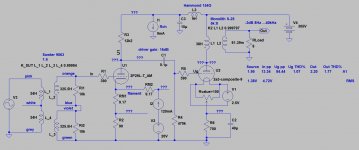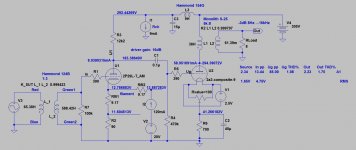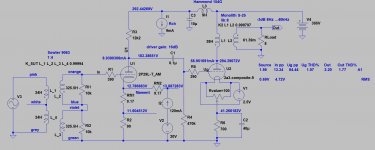Good starting.
It's the straight way to buy better -and more expensive- SUT. 😉
"
124B
Features:
Designed for general purpose or replacement use in push-
pull or phase inverter tube driver circuits.
Frequency response 150Hz-15KHz (+1/-3dB) @1KHz
reference."
It's the straight way to buy better -and more expensive- SUT. 😉
"
124B
Features:
Designed for general purpose or replacement use in push-
pull or phase inverter tube driver circuits.
Frequency response 150Hz-15KHz (+1/-3dB) @1KHz
reference."
Good starting. It's the straight way to buy better -and more expensive- SUT. 😉
124B Features:
Designed for general purpose or replacement use in push-
pull or phase inverter tube driver circuits.
Frequency response 150Hz-15KHz (+1/-3dB) @1KHz
reference."
It's not as ordinary as it looks on paper. It sounded better than a LL1540 for instance, though that's not difficult. I haven't measured the FR but I'm not missing any bass or treble with my 2-way stand mounts. One thing I've learned from using it is that 1:3 is the right ratio. No need to go to 1:4 in my system. My friend Geoff pointed out that the reflected impedance to source would be 100K/9 = 11.1K. A 1:4 ratio would be 100K/16 = 6.3K. Not so good.
But yes, I'm now curious about better SUTs. One question - I've seen some UTC A-20 for sale. Would this work? I can't find any data for it - just what's written on the case.
From UTC datasheet:
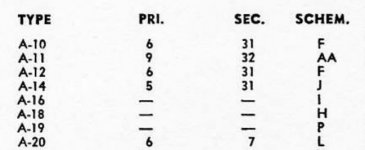
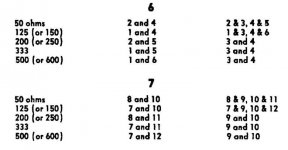
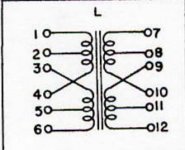
There are some other data:
https://reverb.com/item/28288317-utc-a-20-nos-matching-transformer-1950s
BTW A-20 sometimes as pricey as good Sowter or Lundahl.



There are some other data:
https://reverb.com/item/28288317-utc-a-20-nos-matching-transformer-1950s
BTW A-20 sometimes as pricey as good Sowter or Lundahl.
Thanks for that, Bela. What I need is an explanation of how to wire this up in something like 1:3. I just see various primary and secondary resistances. Can somebody convert these into a ratio? Would it be suitable as an input step-up to a tube stage from a DAC source?
I'm guessing 50R into 500R would give a ratio of approximately 1:3.2. That's just a guess.
I'm guessing 50R into 500R would give a ratio of approximately 1:3.2. That's just a guess.
Last edited:
As you can see in data table, this device is low-mid impedance to low-mid impedance transformer.
If you choose "50 Ohm" as primary and "500Ohm" as secondary option, the transfer ratio is
SQRT(500/50)=3.16
I'm afraid, that these type transformers behaviour would not be as good as in datasheet if the source impedance very high.
If you choose "50 Ohm" as primary and "500Ohm" as secondary option, the transfer ratio is
SQRT(500/50)=3.16
I'm afraid, that these type transformers behaviour would not be as good as in datasheet if the source impedance very high.
I'm kinda following this waiting for a cool schematic to emerge, I have a pair of these Jensens, I bought them thinking I'd want to do something with the XLR outputs of my DAC. 1:1.4
https://www.jensen-transformers.com/wp-content/uploads/2014/08/jt-11p4-11.pdf
https://www.jensen-transformers.com/wp-content/uploads/2014/08/jt-11p4-11.pdf
The most suitable UTC A-series transformer for your 1 to 3 step-up ratio purpose would be A-34 with 6250Ω:500Ω in reverse so you get around 1 to 3.5 step-up ratio. Unfortunately they are the same ones used in the Shure SE-1 stereo phono preamp as output transformers so they won't be cheap.


A-20 can be configured to 1:3 step-up. It will be 150:1.3K, without any deterioration of frequency response. 100-150R is a typical output impedance of a CD player.
Andy - you do not have to terminate the secondary with a 100 K resistor. Audio transformers work best unloaded. You will likely have better sound if you remove this resistor.
Andy - you do not have to terminate the secondary with a 100 K resistor. Audio transformers work best unloaded. You will likely have better sound if you remove this resistor.
To expand on that, A-20 has four 150R windings. For 1:3 step-up ratio (150R:1.3K), the primary is one of these four windings, and the secondary is three remaining windings connected in series. I can post, if necessary, what terminal numbers need to be joined for this configuration.
Something in the Hammond 850 or 800 series might also get you close for probably much less. With the caveat the samples on hand are decades old they generally measure very well.
Second that. Nice professional quality transformers with high permeability cores. 804A is near equivalent of A20, but A-20 has somewhat better frequency response.Something in the Hammond 850 or 800 series might also get you close for probably much less. With the caveat the samples on hand are decades old they generally measure very well.
Last edited:
Price/performance comparison of UTC matching transformers
All 600:600 with multiple taps.
Fair eBay prices.
O-30. $20-30. This is miniature unit. Rated frequency response is 100-20,000. However, this is with 20 mA DC in primary. With no DC, it will be likely 50-20,000. Then, with 150 Ohm source (CD player), it will be better than 20-20,000. Maximum signal level is more than enough for 2 Vrms input. Permalloy core. Low distortion << 1% at all but lowest frequencies. Despite low price, this is adequate, high quality transformer for input duty. May need additional shielding.
A20. $80-100. 10-50,000. Better than that with lower impedance source. Permalloy core and hum-bucking construction.
HA-108. $150-200. Ultimate in performance and quality. Hipermalloy core makes it virtually distortion-free even at the lowest frequencies.
All 600:600 with multiple taps.
Fair eBay prices.
O-30. $20-30. This is miniature unit. Rated frequency response is 100-20,000. However, this is with 20 mA DC in primary. With no DC, it will be likely 50-20,000. Then, with 150 Ohm source (CD player), it will be better than 20-20,000. Maximum signal level is more than enough for 2 Vrms input. Permalloy core. Low distortion << 1% at all but lowest frequencies. Despite low price, this is adequate, high quality transformer for input duty. May need additional shielding.
A20. $80-100. 10-50,000. Better than that with lower impedance source. Permalloy core and hum-bucking construction.
HA-108. $150-200. Ultimate in performance and quality. Hipermalloy core makes it virtually distortion-free even at the lowest frequencies.
Yes - indeed. I've been looking at the Hammond range. Examples:Something in the Hammond 850 or 800 series might also get you close for probably much less. With the caveat the samples on hand are decades old they generally measure very well.
1140-LN-C 4:1 36K:2.2K, 10K:600 £33 Nickel alloy core, mumetal shield
1140-LN-D 4:1 40K:2.4K £60 Nickel alloy core, mumetal shield
832A 4:1 80K:5K £105 cased, broadcast 65x44x32mm
834A 2:1 40K:5K £105 cased, broadcast 0.2kg
812A 1:4 150/600:12K/48K £105 Line to grid
844A 4.5:1 12K/48K:150/600 £105 PP plates to line
850LA 3:1 5K/20K:150/600 £115 OP-Line, matching
850NA 1:4 150/600:10K/40K £115 OP-Line, matching
560L 1:3 150/600:5K/20K £52 Collector-Line, matching
560N 1:4 150/600:10K/40K £52 Collector-Line, matching
I would be inclined to try the cheaper ones first, like 1140-LN-C £33+, 560L £52+, 1140-LN-D £60+ (though this doesn't look any better than the 1140-LN-C). The 560L looks like the 850LA but without the shielding case.
Has anyone tried any of these?
Hammond 1140 series prices in EU:
https://www.don-audio.com/navi.php?JTLSHOP=19df06cda68bb4f4445b4846cca793bc&suchausdruck=1140
https://www.don-audio.com/navi.php?JTLSHOP=19df06cda68bb4f4445b4846cca793bc&suchausdruck=1140
Thanks - I would be buying in the UK from KGA Enclosures.Hammond 1140 series prices:
https://www.don-audio.com/navi.php?JTLSHOP=19df06cda68bb4f4445b4846cca793bc&suchausdruck=1140
https://www.kgaenclosures.com/Hammond-Manufacturing/Transformers-Price-List.php KGA Tel: 01535 636856
I think after 15 years or so of chasing the dream of a 2a3 amp that really satisfies me, this is maybe the closest I've come. All-DHT. One could throw money at it and use a 10Y input and a high-end SUT like amorphous or whatever but the formula of SUT > DHT > 2a3 looks a good one. Thomas Mayer did it with 10Y into 45, Ale Moglia with 47 into 300B, and both used the LL7903. I'm after something cheaper and hopefully better too. Even with the 124B at present, the tone and transparency is really good. Doing a lot of listening to familiar tracks and liking it!
Attachments
Last edited:
My next pair of SUTs are likely to be 1:4 which is more common than 1:3. But 1:3 suits my own system. I don't listen loud and my volume control is in software on my Mac Pro which is my only source, so 80% is about right and means I don't have to attenuate much in the digital domain. But your point is well taken and I will be looking at 1:4 choices. I'd like to stay with a nominal 2V line input and if I change DACs I'll look at how to do that.If you use 1:3 SUT (instead of 1:4), you will get only about 2dB headroom up to source (DAC?) 2VRMS voltage, so the input potentiometer will be at about 80%.
If you want to use another -lower output- source, the overall gain wouldn't be enough.
I checked in to see if I had posted the value of the dropping resistors I employed to keep the 6SL7 heater down to 6.3V. Boy, you miss the "new response" email one time and just look at ALL THIS! 😆
Incase anyone happens still to be interested in 2A3 circuits, I haven't yet breadboarded the Lipman direct-coupled amp. That's because I listened to my 1626 headphone amp one night and couldn't stand it anymore after hearing how good the 2A3 circuits sounded with speakers. So, I've been converting it to a 45 amp. It still has the 6SL7 (actually 6SU7GTY) up front in what will be the JE Labs simple 45 (same as the first 2A3 circuit I posted in this thread, and still my favorite). I also kept the 8532 as an option (selectable by switch), which will run at 150Vak/5mA. Most of the iron and other components will stay; kind of nice not to do a from-scratch build but it's a little annoying to deal with prior build decisions that I would NOT make now.
It's completing a circle, in a way, because I started working on this 2A3 project by accident (or opportunism) while unsuccessfully seeking an OPT winder who could make a pair of transformers for the 45 tube that also had a 32 ohm secondary for headphones (excessive demand, labor shortage, etc.). While asking around, Bud Purvine had some 2A3 OPTs left over from O-Netics, so I purchased a pair because it seemed like a cool opportunity, and that's why I got on that track. Now, however, I realized I could revise the headphone amp because the Lundahl LL2765 have 5K primaries suitable for the 45 tube. Just have to keep the primary DC current at 30mA or below, which should work fine. So the 45 headphone experience will still happen and there'll be a stellar 2A3 amp on speakers (with a headphone tap as well -- internal L-pad off the 4 ohm secondary).
Anyway, I should have something to post second half of the week.
Incase anyone happens still to be interested in 2A3 circuits, I haven't yet breadboarded the Lipman direct-coupled amp. That's because I listened to my 1626 headphone amp one night and couldn't stand it anymore after hearing how good the 2A3 circuits sounded with speakers. So, I've been converting it to a 45 amp. It still has the 6SL7 (actually 6SU7GTY) up front in what will be the JE Labs simple 45 (same as the first 2A3 circuit I posted in this thread, and still my favorite). I also kept the 8532 as an option (selectable by switch), which will run at 150Vak/5mA. Most of the iron and other components will stay; kind of nice not to do a from-scratch build but it's a little annoying to deal with prior build decisions that I would NOT make now.
It's completing a circle, in a way, because I started working on this 2A3 project by accident (or opportunism) while unsuccessfully seeking an OPT winder who could make a pair of transformers for the 45 tube that also had a 32 ohm secondary for headphones (excessive demand, labor shortage, etc.). While asking around, Bud Purvine had some 2A3 OPTs left over from O-Netics, so I purchased a pair because it seemed like a cool opportunity, and that's why I got on that track. Now, however, I realized I could revise the headphone amp because the Lundahl LL2765 have 5K primaries suitable for the 45 tube. Just have to keep the primary DC current at 30mA or below, which should work fine. So the 45 headphone experience will still happen and there'll be a stellar 2A3 amp on speakers (with a headphone tap as well -- internal L-pad off the 4 ohm secondary).
Anyway, I should have something to post second half of the week.
- Home
- Amplifiers
- Tubes / Valves
- Developing a 2A3 SET
